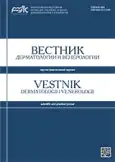Принципы ведения больных врожденным буллезным эпидермолизом
- Авторы: Карамова А.Э.1, Альбанова В.И.1, Мончаковская Е.С.1
-
Учреждения:
- Государственный научный центр дерматовенерологии и косметологии Министерства здравоохранения Российской Федерации
- Выпуск: Том 95, № 4 (2019)
- Страницы: 24-30
- Раздел: ОБЗОР ЛИТЕРАТУРЫ
- Статья получена: 19.10.2019
- Статья одобрена: 19.10.2019
- Статья опубликована: 19.08.2019
- URL: https://vestnikdv.ru/jour/article/view/501
- DOI: https://doi.org/10.25208/0042-4609-2019-95-4-24-30
- ID: 501
Цитировать
Полный текст
Аннотация
Врожденный буллезный эпидермолиз (ВБЭ) — клинически и генетически гетерогенная группа наследственных заболеваний кожи, характеризующаяся образованием пузырей и/или эрозий в ответ на незначительное механическое воздействие. В настоящее время этиопатогенетические методы лечения заболевания находятся на разных этапах клинических исследований, поэтому наружная терапия, включающая уход за пораженной и непораженной кожей, остается основным методом лечения. Цель терапии заключается в сокращении сроков заживления эрозивно-язвенных дефектов кожи и повышении качества жизни больных. В обзоре представлены клинические рекомендации по ведению больных ВБЭ, разработанные разными группами экспертов, которыми изложены методы лечения больных ВБЭ, основные принципы наружной терапии, купирования субъективных ощущений, и особые ситуации, которые могут встречаться при данной патологии.
Об авторах
А. Э. Карамова
Государственный научный центр дерматовенерологии и косметологии Министерства здравоохранения Российской Федерации
к.м.н., заведующий отделом дерматологии,
107076, г. Москва, ул. Короленко, д. 3, стр. 6
РоссияВ. И. Альбанова
Государственный научный центр дерматовенерологии и косметологии Министерства здравоохранения Российской Федерации
Автор, ответственный за переписку.
Email: albanova@rambler.ru
д.м.н., доцент, ведущий научный сотрудник отдела дерматологии,
107076, г. Москва, ул. Короленко, д. 3, стр. 6
РоссияЕ. С. Мончаковская
Государственный научный центр дерматовенерологии и косметологии Министерства здравоохранения Российской Федерации
младший научный сотрудник отдела дерматологии,
107076, г. Москва, ул. Короленко, д. 3, стр. 6
РоссияСписок литературы
- Fine J. D., Eady R. A., Bauer E. A. et al. The classification of inherited epidermolysis bullosa (EB): report of the third international consensus meeting on diagnosis and classification of EB. J Am Acad Dermatol. 2008;58:931–950.
- Fine J. D., Bruckner-Tuderman L., Eady R. A. et al. Inherited epidermolysis bullosa: Updated recommendations on diagnosis and classification. J Am Acad Dermatol. 2014;70:1103–1126.
- Fine J. D. Inherited epidermolysis bullosa. Orphanet J Rare Dis. 2010;5–12.
- Fine J. D., Johnson L. B., Weiner M. et al. Pseudosyndactyly and musculoskeletal deformities in inherited epidermolysis bullosa (EB): experience of the National EB Registry, 1986–2002. J Hand Surg (British and European Volume). 2005;30B:14–22.
- Petrof G., Abdul-Wahab A., McGrath J. A. Cell Therapy in Dermatology. Cold Spring Harb Perspect Med. 2014;4:a015156.
- Nyström A., Bruckner-Tuderman L., Kern J. S. Cell- and protein-based therapy approaches for epidermolysis bullosa. Methods Mol Biol. 2013;961:425–440.
- Georgiadis C., Syed F., Petrova A. et al. Lentiviral engineered fibroblasts expressing codon-optimized COL7A1 restore anchoring fibrils in RDEB. J Invest Dermatol. 2016;136:284–292.
- Hirsch T., Rothoeft T., Teig N. et al. Regeneration of the entire human epidermis using transgenic stem cells. Nature. 2017;551:327–332.
- Carulli S., Contin R., De Rosa L., Pellegrini G., De Luca M. The long and winding road that leads to a cure for epidermolysis bullosa. Regen Med. 2013;8:467–481.
- Pope E., Lara-Corrales I., Mellerio J. et al. A consensus approach to wound care in epidermolysis bullosa. J Am Acad Dermatol. 2012;67(5):904–917.
- Denyer J., Pillay E. Best practice guidelines for skin and wound care in epidermolysis bullosa. International Consensus. DEBRA, 2012.
- Denyer J., Pillay E., Clapham J. Best practice guidelines for skin and wound care in epidermolysis bullosa. An International Consensus. Wounds International. 2017.
- Fine J. D, Mellerio J. Extracutaneous manifestations and complications of inherited epidermolysis bullosa, Part II: other organs. J Am Acad Dermatol. 2009;61:387–402.
- Haynes L. Clinical practice Guidelines for nutrition support in infants and children with epidermolysis bullosa (EB). UK: DEBRA; 2007.
- Cianfarani F., Zambruno G., Castiglia D., Odorisio T. Pathomechanisms of altered wound healing in recessive dystrophic epidermolysis bullosa. Am J Pathol. 2017;187:1445–1453.
- Sindgikar V., Narasanagi B., Tejasvini V., Ragate A., Patel F. A. Effect of serum albumin in wound healing and its related complications in surgical patients. Al Ameen J Med Sci. 2017;10(2):132–135.
- Moss K. Contact at the borderline: psychoanalytic psychotherapy with EB patients. British Journal of Nursing. 2008;17(7):449.
- Snauwaert J. J. L., Yuen W. Y., Jonkman M. F., Moons P., Naulaers G., Morren M. A. Burden of itch in epidermolysis bullosa. Br J Dermatol. 2014;171:73–78.
- Henderson J., Fuguson M., Terenghi G. The feeling of healing. Plast Reconstr Surg. 2012;129:223–224.
- Harding K., Cutting K., Price P. The cost-effectiveness of wound management protocols of care. Вritish Journal оf Nursing. 2000;9(19): Tissue Viability Supplement: S6, S8, S10 passim.
- Azizkhan R. G., Denyer J. E., Mellerio J. E. et al. Surgical management of epidermolysis bullosa: Proceedings of the IInd International Symposium on Epidermolysis Bullosa, Santiago, Chile, 2005. Int J Dermatol. 2007;46:801–808.
- Denyer J. E. The Use of Atraumatic Wound Dressings in Epidermolysis Bullosa. 2006. http://old.ewma.org/fileadmin/user_upload/EWMA/ pdf/conference_abstracts/2006/posters/p172.pdf
- Ly L., Su J. C. Dressings used in epidermolysis bullosa blister wounds: a review. Journal of Wound Care. 2008;17:482, 484–486, 488, passim.
- Nesi-Reis V., Lera-Nonose D., Oyama J. et al. Contribution of photodynamic therapy in wound healing: A systematic review. Photodiagnosis and Photodynamic Therapy. 2018;21:294–305.
- Keast D. H., Bowering C. K., Evans A. W., Mackean G.. L., Burrows C., D’Souza L. MEASURE: a proposed assessment framework for developing best practice recommendations for wound assessment. Wound Repair Regen. 2004;12(3 Suppl):1–17.
- Vanden Oever M., Twaroski K., Osborn M. J. et al. Inside out: regenerative medicine for recessive dystrophic epidermolysis bullosa. Pediatr Res. 2018;83(1–2):318–324.
- Mellerio J. E., Robertson S. J., Bernardis C. et al. Management of cutaneous squamous cell carcinoma in patients with epidermolysis bullosa: best clinical practice guidelines. Br J Dermatol. 2016;174:56–67.
Дополнительные файлы








